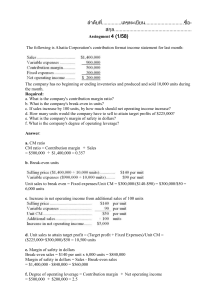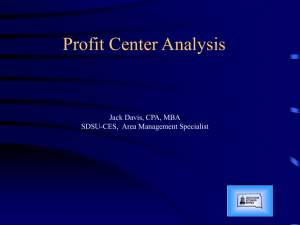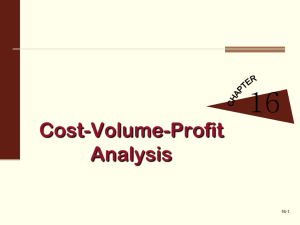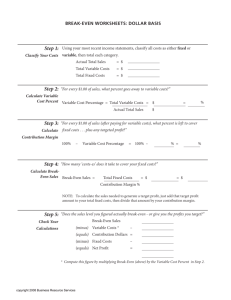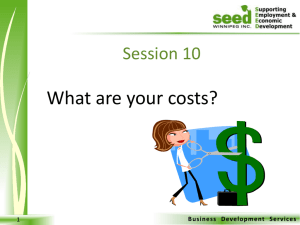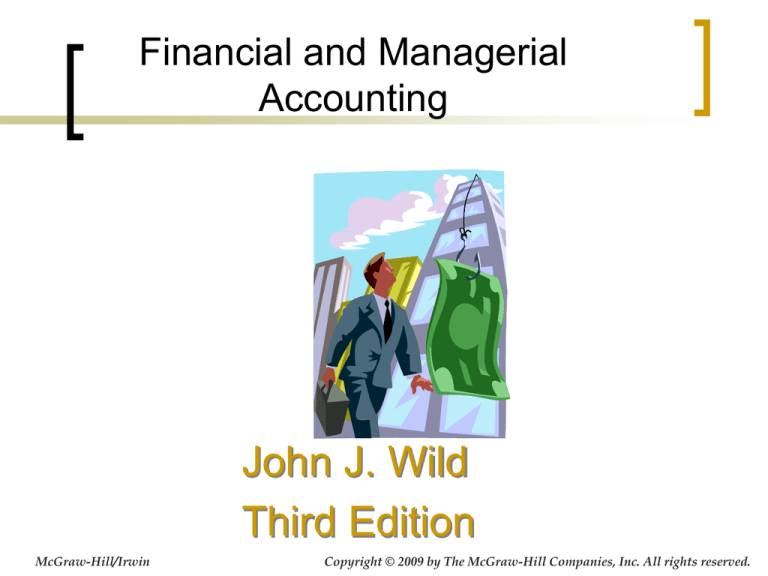
Financial and Managerial
Accounting
John J. Wild
Third Edition
McGraw-Hill/Irwin
Copyright © 2009 by The McGraw-Hill Companies, Inc. All rights reserved.
Chapter 18
Cost Behavior and
Cost-Volume-Profit
Analysis
Conceptual Learning
Objectives
C1: Describe different types of cost
behavior in relation to production and
sales volume.
C2: Identify assumptions in cost-volume
profit analysis and explain their
impact.
C3: Describe several applications of costvolume-profit analysis.
18-3
Analytical Learning Objectives
A1: Compare the scatter diagram, highlow, and regression methods of
estimating costs.
A2: Compute contribution margin and
describe what it reveals about a
company’s cost structure.
A3: Analyze changes in sales using the
degree of operating leverage.
18-4
Procedural Learning
Objectives
P1: Determine cost estimates using three
different methods.
P2: Compute the break-even point for a
single product company.
P3: Graph costs and sales for a single
product company.
P4: Compute break-even point for a
multiproduct company.
18-5
C2
Questions Addressed by
Cost-Volume-Profit Analysis
CVP analysis is used to answer questions
such as:
What sales volume is needed to earn a
target income?
What is the change in income if selling
prices decline and sales volume
increases?
How much does income increase if we
install a new machine to reduce labor
costs?
What is the income effect if we change the
sales mix of our products or services?
18-6
C1
Total Fixed Cost
Monthly Basic
Telephone Bill
Total fixed costs remain unchanged
when activity changes.
Number of Local Calls
Your monthly basic
telephone bill probably
does not change when
you make more local calls.
18-7
C1
Fixed Cost Per Unit
Your average cost per
local call decreases as
more local calls are made.
Monthly Basic Telephone
Bill per Local Call
Fixed costs per unit decline
as activity increases.
Number of Local Calls
18-8
C1
Total Variable Cost
Total Long Distance
Telephone Bill
Total variable costs change
when activity changes.
Minutes Talked
Your total long distance
telephone bill is based
on how many minutes
you talk.
18-9
C1
Variable Cost Per Unit
The cost per long distance
minute talked is constant.
For example, 7
cents per minute.
Per Minute
Telephone Charge
Variable costs per unit do not change
as activity increases.
Minutes Talked
18-10
C1
Cost Behavior Summary
Summary of Variable and Fixed Cost Behavior
Cost
In Total
Per Unit
Variable
Changes as activity level
changes.
Remains the same over wide
ranges of activity.
Fixed
Remains the same even
when activity level changes.
Dereases as activity level
increases.
18-11
C1
Mixed Costs
Mixed costs contain a fixed portion
that is incurred even when the
facility is unused, and a variable
portion that increases with usage.
Example: monthly electric utility
charge
Fixed service fee
Variable charge per
kilowatt hour used
18-12
C1
Step-Wise Costs
Cost
Total cost remains
constant within a
narrow range of
activity.
Activity
18-13
P1
Identifying and Measuring
Cost Behavior
The objective
is to classify
all costs as
either fixed or
variable.
18-14
P1
Scatter Diagram
Total Cost in
1,000’s of Dollars
Unit Variable Cost = Slope =
20
10
* *
* *
Δ
Δ
in cost
in units
* ** *
**
Vertical
distance
is the
change
in cost.
Horizontal distance is
the change in activity.
0
0
1
2
3
4
Activity, 1,000’s of Units Produced
18-15
P1
The High-Low Method
The following relationships between units
produced and costs are observed:
High activity level
Low activity level
Change
Units
67,500
17,500
50,000
Cost
$ 29,000
20,500
$ 8,500
Using these two levels of activity, compute:
the variable cost per unit.
the total fixed cost.
18-16
P1
The High-Low Method
High activity level
Low activity level
Change
Units
67,500
17,500
50,000
Cost
$ 29,000
20,500
$ 8,500
Δ
Unit variable cost =
Δ
Fixed cost = Total cost – Total variable cost
$8,500
in cost
=
= $0.17 /unit
in units $50,000
Fixed cost = $29,000 – ($0.17 per unit × $67,500)
Fixed cost = $29,000 – $11,475 = $17,525
18-17
P1
Least-Squares Regression
Least-squares regression is usually covered
in advanced cost accounting courses. It is
commonly used with spreadsheet
programs or calculators.
The objective of the cost
analysis remains the
same: determination of
total fixed cost and the
variable unit cost.
18-18
P2
Computing Break-Even Point
The break-even point (expressed in
units of product or dollars of sales) is
the sales level at which a company
earns neither a profit nor incurs a
loss.
18-19
P2
Computing Break-Even Point
Sales Revenue (2,000 units)
Less: Variable costs
Contribution margin
Less: Fixed costs
Net income
Total
$ 200,000
140,000
$ 60,000
24,000
$ 36,000
Unit
$ 100
70
$ 30
Contribution margin is amount by which revenue
exceeds the variable costs of producing the revenue.
18-20
P2
Computing Break-Even Point
Sales Revenue (2,000 units)
Less: Variable costs
Contribution margin
Less: Fixed costs
Net income
Total
$ 200,000
140,000
$ 60,000
24,000
$ 36,000
Unit
$ 100
70
$ 30
How much contribution margin must this company
have to cover its fixed costs (break even)?
Answer: $24,000
18-21
P2
Computing Break-Even Point
Sales Revenue (2,000 units)
Less: Variable costs
Contribution margin
Less: Fixed costs
Net income
Total
$ 200,000
140,000
$ 60,000
24,000
$ 36,000
Unit
$ 100
70
$ 30
How many units must this company sell to cover its
fixed costs (break even)?
Answer: $24,000 ÷ $30 per unit = 800 units
18-22
P2
Computing Break-Even Point
We have just seen one of the basic CVP
relationships – the break-even
computation.
Break-even point in units =
Fixed costs
Contribution margin per unit
Unit sales price less unit variable cost
($30 in previous example)
18-23
P2
Computing Break-Even Point
The break-even formula may also be
expressed in sales dollars.
Break-even point in dollars =
Fixed costs
Contribution margin ratio
Unit contribution margin
Unit sales price
18-24
P3
Preparing a CVP Chart
Costs and Revenue
in Dollars
Plot total fixed costs on the vertical axis.
Total fixed costs
Total costs
Draw the total cost line with a slope
equal to the unit variable cost.
Volume in Units
18-25
P3
Preparing a CVP Chart
Starting at the origin, draw the sales line
Sales
Costs and Revenue
in Dollars
with a slope equal to the unit sales price.
Total fixed costs
Total costs
Breakeven
Point
Volume in Units
18-26
C2
Assumptions of CVP Analysis
A limited range of activity called the relevant
range, where CVP relationships are linear.
Unit selling price remains constant.
Unit variable costs remain constant.
Total fixed costs remain constant.
Production = sales (no inventory changes).
18-27
C3
Computing Income
from Expected Sales
Income (pretax) = Sales – Variable costs – Fixed
costs
18-28
C3
Computing Sales for a Target
Income
Break-even formulas may be
adjusted to show the sales volume
needed to earn any amount of
income.
Unit sales =
Fixed costs + Target income
Contribution margin per unit
Fixed costs + Target income
Dollar sales =
Contribution margin ratio
18-29
C3
Computing Sales (Dollars) for a
Target Net Income
Target net income is income after
income tax. But we can use target
income before tax in our
calculations.
Dollar sales =
Fixed + Target income
costs
before tax
Contribution margin ratio
18-30
C3
Computing Sales (Dollars) for a
Target Net Income
To convert target net income to
before-tax income, use the
following formula:
Target net income
Before-tax income =
1 - tax rate
18-31
C3
Computing the Margin of
Safety
Margin of safety is the amount by which
sales can drop before the company
incurs a loss.
Margin of safety may be expressed as a
percentage of expected sales.
Margin of safety
percentage
=
Expected sales - Break-even sales
Expected sales
18-32
C3
Sensitivity Analysis
The basic CVP relationships may be
used to analyze a number of
situations such as changing sales
price, changing variable cost, or
changing fixed cost.
Continue
18-33
P4
Computing Multiproduct
Break-Even Point
The CVP formulas may be modified for use when a
company sells more than one product.
The unit contribution margin is replaced with the
contribution margin for a composite unit.
A composite unit is composed of specific
numbers of each product in proportion to the
product sales mix.
Sales mix is the ratio of the volumes of the
various products.
18-34
P4
Computing Multiproduct
Break-Even Point
The resulting break-even formula
for composite unit sales is:
Break-even point
in composite units
=
Fixed costs
Contribution margin
per composite unit
18-35
A3
Operating Leverage
A measure of the extent to which fixed
costs are being used in an organization.
A measure of how a percentage change in
sales will affect profits.
Contribution margin
Pretax income
= Degree of operating leverage
18-36
End of Chapter 18
18-37

